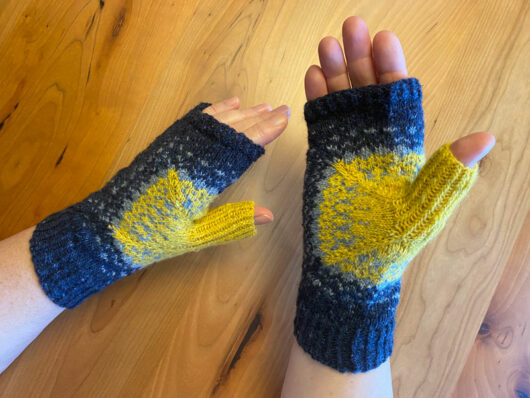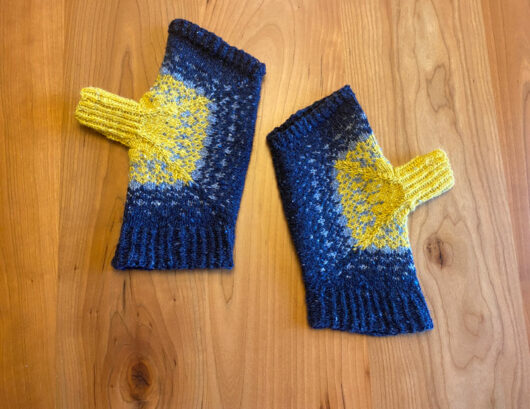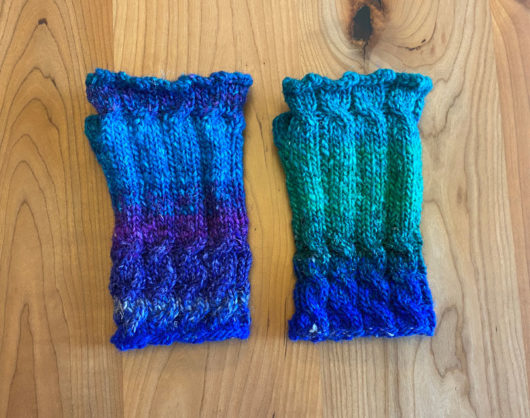
It’s time to bundle up your and yours’s (OK, I made that contraction up but it’s still kind of a good one)…it’s time to bundle all hands in good warm wool.
These mittens are Jane Richmond’s Woodstack Mittens. I knit this pair in Kelbourne Woolens’ Germantown in the Wild Rose colorway. Excellent pattern. Wonderful wool. But a long way price-wise from the “dime store” Germantown from decades past.
I made a few minor modifications. Instead of working a plain k1, p1 ribbing, I followed the lead of some Ravelers who worked the ribbing in knit one through the back, purl one. I think it makes for a more crisp ribbing.
And when I started the body of the mitt I could see clearly this was going to be a bit roomier than I wanted, so I didn’t change needle size. I knit the entire mitten on US size 6.
I also picked up 2 stitches at the base of the thumb as I was taking the stitches off the waste yarn. On the first round I immediately knit those 2 stitches together with the first and the last of the live stitches. It still left the typical hole to sew up at the base of the thumb. But it worked out well.
Both mittens are the same. So no fussing about which is left and which is right. I cast on for a second pair almost immediately after finishing my first pair. Again I used Kelbourne Woolens Germantown, this time in their Natural colorway.

I don’t begrudge the price (much) of Germantown. The yarn was evenly spun. In the 3 skeins I’ve worked with lately there were no knots at all. I understand we knitters need to be tolerant of a knot or two in a skein. But it’s a delight to not have to deal with any knots in a small project. Of course, your mileage may vary.
Woodstack Mittens have rather squared-off tops, ending with 18, 22, or 26 stitches to be kitchenered together (depending on the size you’re knitting). I like that. It’s a tad extra work compared to a gathered top. But the shape fits the hand well.
Next up is yet another pair of Cheryl Niamath’s Fetching mitts. This is the 13th time I’ve knit these. Most of them, as here, I’ve knit in Noro Silk Garden. While 13 times is nothing to sneeze at, my friend Dot has knit this pattern 61 times! And I think she’s gifted almost all of them. This is truly an epicly great pattern–and a free one to boot. There are currently 21,362 project pages on Ravelry. And, obviously, not everyone posts every finished project on the site.

Fetching is an easy peasy knit with just enough detail to keep it interesting. Notice that the cables move in opposite directions on the two hands. If what hands need is warmth without confining the fingertips, Fetching is a must-knit pattern.
I had a bright red skein of Brown Sheep Nature Spun Worsted in my stash just itching to be knit into mittens. I decided to give another very successful freebie pattern a try: Karen Hoyle’s Comfy Gusset Mittens.

I first saw the pattern knit by a member of the I Make Mittens Ravelry group. The knitter raved about them and I decided to give them a try. As you can tell from the photo, the thumb-gusset increases line up in an atypical way. The heavily-slanted gusset allows for tons of movement in the thumb. Big hands, and that includes mine, are especially comfy in these.
Mittens can be complex knits though within a simple template. They’re exceptionally beautiful in the hands of those skilled in fair isle and embroidery. But there’s an allure to the simple quick knits featured here. No one’s tempted to think they’re too good for snowball fights. If they felt it’s likely OK because you’ve probably knit them a tad roomy. And if you make them three mitts at a time, when you can lose one you’ll still have a pair to wear.



































